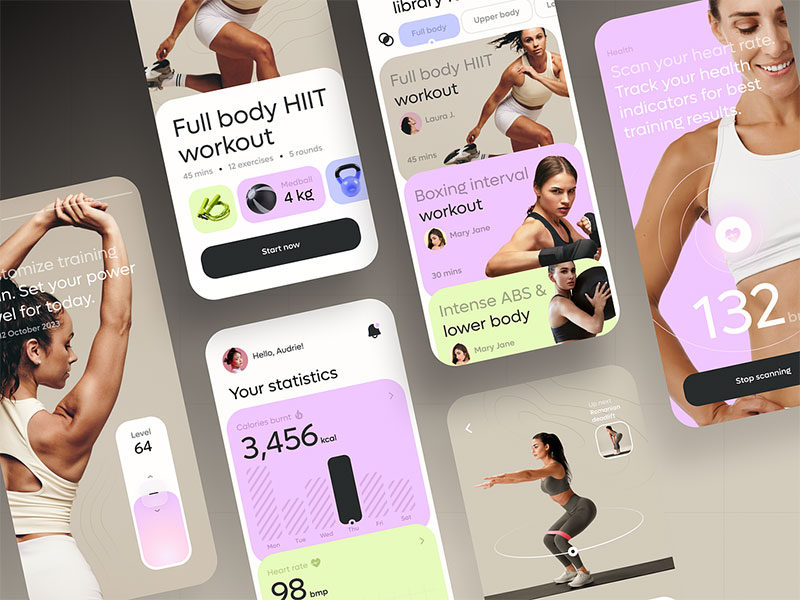Imagine unwrapping a brand new smartphone. That first tap feels magical, right? Now envision that same magic every time you flick open a fitness app.
What’s the secret? It’s all in the design. We’re diving headfirst into the world where aesthetics meet action, where every swipe fuels motivation to keep your heart pumping and calories burning.
This isn’t just about pretty screens; we’re exploring how clever UI can turn a humdrum workout into a digital high-five for your health.
Your takeaway?
Cross-platform fitness solutions that feel personal because they are. You’ll understand how user experience, health tracking features, and wearable device compatibility merge to keep you, or your users, right on track with wellness goals.
Get ready to peel back the curtain on fitness app design as we stitch together UX elements, interactive platform quirks, and the nuts and bolts that spin the gears behind the scenes. Fasten your seatbelts; it’s going to be one engaging ride through design anatomy.
Fitness App Design Examples
FAQ about fitness app design
What is the core purpose of fitness app design?
Design? It’s the blueprint for connection. It goes beyond aesthetics, crafting a user’s journey to better health. We’re talking usability blended with motivation.
Through intuitive interfaces and personalization, you’re not just designing an app; you’re crafting a companion in users’ fitness pursuits.
How crucial is user interface in a fitness app?
Can’t understate this – it’s like the handshake of your app. A clean UI invites users in and keeps ’em coming back. You want those taps and swipes to feel effortless.
Make it look good, but simplify the navigation; no one wants to get lost before breaking a sweat.
What features are a must-have for a successful fitness app?
A solid app’s stacked with health tracking features, options for customizable workout plans, and nutritional insights.
Don’t forget social sharing; it’s the digital “cheers” for users. Gamification’s the secret ingredient that spices up the whole experience, making fitness a level-up game.
How does one balance aesthetics with functionality?
It’s a tango between eye-candy and iron-clad utility. Prioritize UI elements that streamline the fitness journey.
Think design anatomy – every pixel should sweat purpose, from widgets tracking progress to buttons that feel like a natural part of the workout flow.
In what way does target audience analysis impact fitness app design?
Knowing your audience is like possessing a fitness oracle. It informs everything – from picking the right exercises to the motivational nudges we wire in.
The trick? Get to know their workout style, tech-savvy levels, and health goals. That way, your app ends up feeling like their digital gym buddy.
Can fitness app design influence user retention?
Absolutely. Picture this: An app sways to the rhythms of users’ needs, offering them just what they need, when they need it.
User engagement metrics inform tweaks and enhancements. Continuous innovation based on data, aligned with superior design, that’s the golden ticket to keeping ’em hooked.
What is the role of personalization in fitness apps?
Personalization? It’s the core of user loyalty. Tailored workout plans, personalized feedback, and progress tracking that adapts to the user – these are not just features; they’re the scaffolding that supports a distinctive user journey.
They transform a generic app into a user’s fitness fingerprint.
How does one ensure accessibility in fitness app design?
In a world brimming with diversity, accessibility is non-negotiable.
Large buttons, readable fonts, voice commands, and screen reader support – these aren’t just thoughtful touches; they’re bridges to a wider audience. Such inclusive design declares, “Everyone’s invited to the fitness fiesta!”
What privacy considerations should be taken into account when designing a fitness app?
Privacy is akin to trust in the digital dojo. You’re handling sensitive health metrics – a misstep here and trust evaporates.
Rigorous data security, transparent privacy policies, and clear user control over personal information – these are the cornerstones of a trustable fitness app.
How does the integration of emerging technologies improve fitness app design?
Here’s where the excitement lives – emerging tech pushes boundaries. AI guides workouts like a pocket personal trainer.
AR transforms living spaces into futuristic gyms. Sync with wearables? That turns real-world movements into in-app triumphs. Weaving in these tech marvels elevates the mundane into an addictive, tech-empowered health quest.
Conclusion
So, we’ve sprinted through the circuit of fitness app design, right? It’s where form and function high-five each other. You’ve seen how every swipe, tap, and scroll makes a user’s heart rate tick just right.
Bold designs, features bursting with smarts—like AI-powered progress trackers and virtual coaching—are the new reps for tech-savvy wellness. Remember though, it’s about more than sharp looks. Data privacy, accessibility, and that personal touch? They’re the true muscle behind the beauty.
- User-friendly interfaces? Check.
- Gamified experiences? Got ’em.
- Health tracking that speaks to you? All here.
Wrapping it up, think of these nuggets as the ultimate design workout. Pull them off, and you’ve got an app that’s less like a tool, more like a workout buddy—one that doesn’t bail.
So, lace up your design sneakers. The race for the sleekest, most intuitive, downright irresistible fitness app is on. Ready, set, design!
If you enjoyed reading this article about Fitness App Design, you should read these as well:
- App Development For iOS: Take Control Of The Mobile Consumer Market
- 7 Common Design Mistakes With Mobile Apps (and How to Do Things Differently)
- Harnessing Artificial Intelligence in Design: A Closer Look at Image-To-Text Applications
- Building a Payment App: Key Considerations and Best Practices for Successful Development
